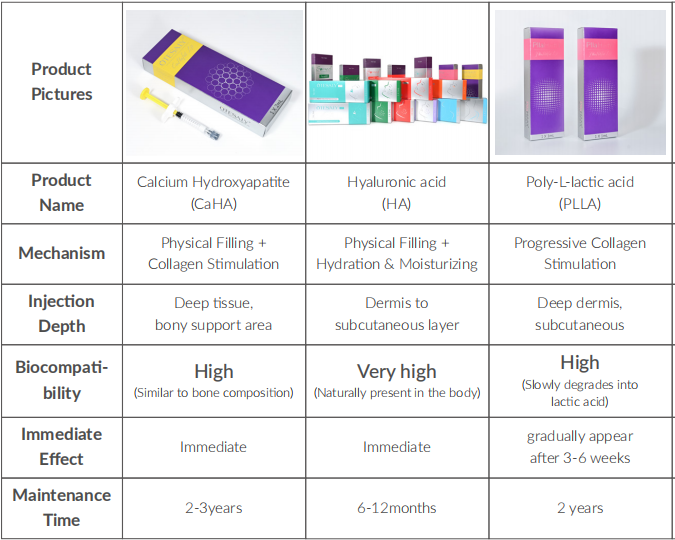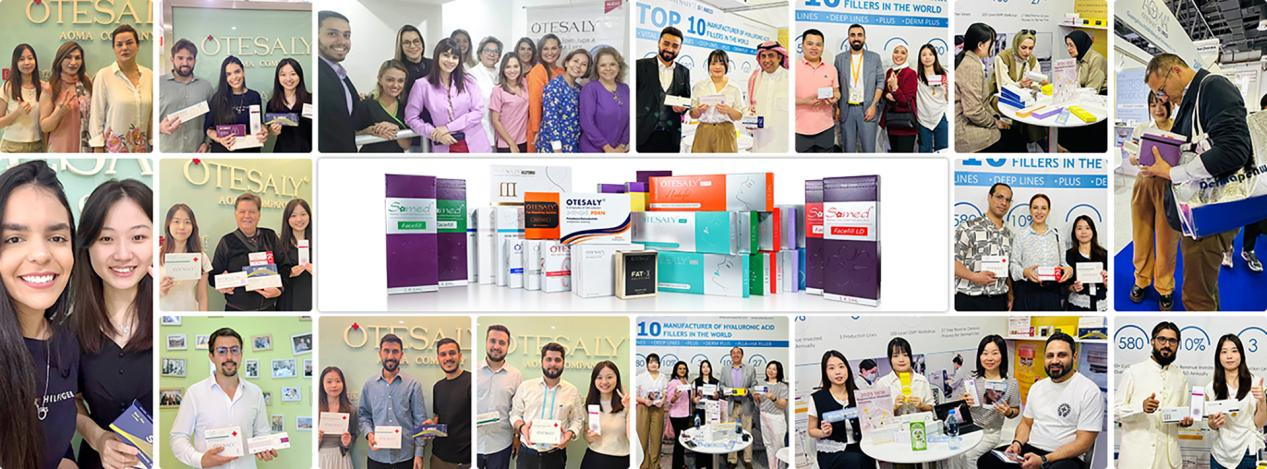In the art and science of middle facial rejuvenation, volume restoration is undoubtedly the golden rule. However, in the face of the dazzling array of filler options on the market, have you ever felt confused: Which material can provide your customers with the most ideal, long-lasting and natural effect?
Hyaluronic acid (HA), hydroxyapatite calcium (CaHA), and poly-L-lactic acid (PLLA) constitute the three pillars of global non-surgical facial lifting. But their core differences are far more than just price and durability.
This article will provide you with a data-driven and highly persuasive clinical decision-making guide by sharing a six-month clinical case of an international client using our AOMA products, comparing and analyzing the mechanism of action and efficacy differences of three mainstream facial filling materials (poly-L-lactic acid, calcium apatite and hyaluronic acid).
Understand the mechanism of action of the three fillers

Hyaluronic acid achieves immediate effects through physical filling
As a naturally occurring glycosaminoglycan in the human body, HA physically replenishes the lost volume through its powerful hydration effect. A 2019 study in the Journal of Cosmetic Dermatology confirmed that the effect of hyaluronic acid fillers lasts for 6 to 12 months and can be completely degraded by injecting hyaluronidase.
CaHA has a dual mechanism of action
This material is composed of 30% calcium apatite microspheres and 70% carboxymethyl cellulose gel. Combining immediate effects with long-term stimulation and providing strong support, it is often used in areas that require strong structural support. Histological studies have shown that the density of newly formed collagen increased by 64.5% three months after injection.
PLLA enables progressive regeneration
As a synthetic polymer with good biocompatibility, PLLA is uniformly implanted into the deep dermis through tiny injection points, gradually stimulating fibroblasts to produce a large amount of autologous collagen. Clinical data shows that the collagen regeneration cycle can last for more than 24 months, with gradual and natural effects that are extremely long-lasting. The best results occur 3 to 6 months after injection, improving the overall skin texture and firmness.
Core Case Study: Panoramic Tracking of Facial Enhancement Effects over 6 Months
One of our long-term cooperative clinics from Europe shared a highly representative case. This clinic has long purchased a variety of high-end fillers including AOMA PLLA from our company. One of their 42-year-old female clients complained of facial volume loss, flat apples of the cheeks, and blurred cheekbone contours, hoping to achieve a natural and long-lasting youthful effect.
The clinic doctor has formulated a comprehensive treatment plan:
Left middle face: Inject CaHA to take advantage of its powerful support and collagen stimulation.
Right middle face: Inject hyaluronic acid (HA) to achieve precise immediate filling and lifting.
Full face: Subcutaneous injections of AOMA PLLA are administered twice (with a 4-week interval) to the full face, aiming to achieve overall skin quality improvement and volume recovery.
Follow-up time points: Before injection, 1 week, 3 months, and 6 months after injection.
Presentation effect analysis:
● One week after injection
Observation: Both the left side (CaHA) and the right side (HA) show significant volume recovery and improvement, and the zygomatic bone contour is immediately enhanced. The HA side has a stronger hydration effect, making the skin texture appear smoother. The overall PLLA effect has not yet been manifested.
Clinical significance: This stage has confirmed the immediate effect of HA and CaHA as "instant fillers", which can quickly meet customers' initial expectations for results.
● Three months after injection
Observation: The effect on the left side (CaHA) has become more integrated and natural, with a firm supporting sensation, demonstrating the initial effectiveness of collagen stimulation. There is slight metabolism on the right side (HA), but it still maintains a good shape. At this point, the effect of AOMA PLLA begins to show significantly: the skin texture all over the body becomes tighter, and the midface presents a "fullness" from the inside out.
Clinical significance: This is a crucial juncture when PLLA begins to gain momentum, and its natural effects start to win favor.
● Six months after injection
Observation: At this point, the differences among the three become highly enlightening.
HA side: There is a significant metabolic effect and a weakened sense of volume. Maintenance treatment should be considered.
CaHA side: The effect remains stable, thanks to the newly formed collagen, and still has good support.
PLLA Comprehensive: The effect reaches its peak. The middle facial tissues are plump and tight, with smooth and natural contours, as if one has returned to a younger state. The client himself was most satisfied with the PLLA effect at six months.
We specially invited the chief doctor of this European clinic to share his real experience:
In the long-term selection of materials, we have been constantly seeking a product that can offer customers a "quiet anti-aging" experience. AOMA PLLA has become our strategic-level choice. As this case demonstrates, HA and CaHA played significant roles in the early stage, but at the critical juncture of six months, the value of PLLA was crushed.
This gradual and imperceptible natural change has greatly enhanced customer satisfaction and loyalty. The easy pushability and good customer tolerance of AOMA PLLA also fill us with confidence in the operation. It has become the core product in our clinic's facial rejuvenation package.
Authoritative Data Support: Why Six Months is the Golden Showcase for PLLA?
Our case observations are highly consistent with the conclusions of authoritative medical literature. A study published in Aesthetic Plastic Surgery titled "Poly-L-lactic Acid for Midface Volume Restoration: The study "A Retrospective Case Series with 12-Month Follow-Up" clearly indicates that the effect of PLLA begins to manifest 1-3 months after injection, reaches its peak at 6 months, and can be stably maintained for 12 months or even longer. This "slow heating" characteristic is precisely the fundamental reason why its effect is extremely natural and similar to the regeneration of its own tissues.
Decision-making Guide: How to Choose the Most Suitable Filler for Your Customers?
| Customer demand profile | Recommended plan | Core value |
| Seeking immediate results or making a first-time attempt at filling | Hyaluronic acid | The effect is precise and reversible, meeting the demand for rapid beauty enhancement. |
| Need strong support and hope to improve my skin quality | CaHA | The dual effect of "filling + stimulation" is combined, providing outstanding support. |
| Seek long-term and natural overall rejuvenation to combat volume loss and relaxation | PLLA | The effect is long-lasting and naturally regenerating, making it a long-term investment that maximizes value. |
Just as the clinic in our case did, combining treatments is often the most efficient strategy. By using AOMA HA or CaHA to address immediate structural and contour issues and simultaneously initiating the long-term regeneration program of AOMA PLLA, you can provide your clients with seamless and continuously optimized treatment outcomes, significantly enhancing the lifetime value of your clients.
Conclusion
Six months of clinical observation confirmed that each of the three filling materials has clear indications. Hyaluronic acid is suitable for cases that pursue immediate effects. Calcium apatite provides an ideal solution for moderate to severe tissue atrophy, while poly-L-lactic acid (AOMA PLLA) has significant advantages in long-term improvement. It is recommended that medical practitioners make a comprehensive choice based on client needs, organizational foundation and expected results.






















